中国沿海省份海洋渔业碳汇的综合估算与时空分异
IF 5.4
2区 环境科学与生态学
Q1 OCEANOGRAPHY
引用次数: 0
摘要
提高海洋渔业的碳汇能力是实现碳中和的关键战略。海洋渔业碳汇的综合估算和时空分异分析是准确评估海洋渔业碳汇潜力的基础。然而,以前的研究主要集中在海洋贝类和藻类水产养殖的碳汇上,而忽视了海洋捕捞渔业的碳汇。在这项研究中,我们开发了一个与海洋贝类养殖、藻类养殖和捕捞渔业相关的碳汇的综合估计框架。我们还对2008 - 2022年中国沿海省份的海洋渔业碳汇进行了全面评估。此外,利用Dagum基尼系数和β-收敛模型分析了中国海洋渔业碳汇的时空分异。结果表明,中国海洋渔业碳汇呈小幅下降趋势,从2008年的1397万吨减少到2022年的1164万吨。中国沿海省份海洋渔业碳汇的空间分布不均衡,东部和南部沿海省份碳汇水平较高,北部沿海省份碳汇水平较低。中国海洋渔业碳汇呈现出β-收敛特征和追赶趋势,碳汇水平越低的地区增长越快。进一步增强海洋渔业碳汇,需要实施额外的海洋渔业碳汇保护和修复项目,优化海洋渔业碳汇区域发展战略,建立激励机制,加快海洋渔业碳汇的完善。本文章由计算机程序翻译,如有差异,请以英文原文为准。
Comprehensive estimation and spatiotemporal differentiation of marine fishery carbon sinks in China's coastal provinces
Increasing the carbon sink capacity of marine fisheries is a key strategy toward achieving carbon neutrality. Comprehensive estimation of marine fishery carbon sinks and analysis of their spatiotemporal differentiation are essential to accurate assessments of their potential. However, previous studies have primarily focused on carbon sinks from marine shellfish and algal aquaculture, while overlooking those from marine capture fisheries. In this study, we developed a comprehensive estimation framework for carbon sinks associated with marine shellfish aquaculture, algal aquaculture, and capture fisheries. We also conducted a thorough assessment of marine fishery carbon sinks in China's coastal provinces from 2008 to 2022. Additionally, the spatiotemporal differentiation of China's marine fishery carbon sink was analyzed using the Dagum Gini coefficient and β-convergence model. The results indicate that China's marine fishery carbon sink has exhibited a slight downward trend, decreasing from 13.97 million tons in 2008 to 11.64 million tons in 2022. The distribution of the marine fishery carbon sink across China's coastal provinces is spatially uneven, with higher levels observed in eastern and southern coastal provinces and lower levels in northern coastal provinces. China's marine fishery carbon sinks exhibit a β-convergence characteristic and a catch-up trend in which regions with lower carbon sink levels experience faster growth. To further enhance the marine fishery carbon sink, it will be essential to implement additional protection and restoration projects, optimize regional development strategies for marine fishery carbon sinks, and establish incentive mechanisms to accelerate the improvement of these carbon sinks.
求助全文
通过发布文献求助,成功后即可免费获取论文全文。
去求助
来源期刊

Ocean & Coastal Management
环境科学-海洋学
CiteScore
8.50
自引率
15.20%
发文量
321
审稿时长
60 days
期刊介绍:
Ocean & Coastal Management is the leading international journal dedicated to the study of all aspects of ocean and coastal management from the global to local levels.
We publish rigorously peer-reviewed manuscripts from all disciplines, and inter-/trans-disciplinary and co-designed research, but all submissions must make clear the relevance to management and/or governance issues relevant to the sustainable development and conservation of oceans and coasts.
Comparative studies (from sub-national to trans-national cases, and other management / policy arenas) are encouraged, as are studies that critically assess current management practices and governance approaches. Submissions involving robust analysis, development of theory, and improvement of management practice are especially welcome.
 求助内容:
求助内容: 应助结果提醒方式:
应助结果提醒方式:


